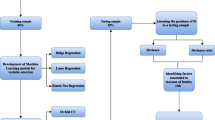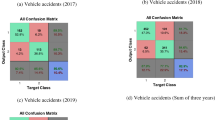Abstract
Statistical models for measuring the impact of adverse weather conditions on pedestrian injuries are of great importance for enhancing road safety measures. The development of these models in the presence of high collinearity among the weather conditions poses a real challenge in practice. The collinearity among these conditions may result in underestimation of the regression coefficients of the regression model, and hence inconsistency regarding the impact of the weather conditions on the pedestrian injuries counts. This paper presents a methodology through which the penalization-based regression is applied to model the impact of weather conditions on pedestrian injury in the presence of a high level of collinearity among these conditions. More specifically, the methodology integrates both the least absolute shrinkage squared operator (Lasso) with the cross-validation approach. The statistical performance of the proposed methodology is assessed through an analytical comparison involving the standard Poisson regression, Poisson generalized linear model (Poisson-GzLM), and Ridge penalized regression model. The mean squared error (MSE) was used as a criterion of comparison. In terms of the MSE, the Lasso-based Poisson generalized linear model (Lasso-GzLM) revealed an advantage over the other regression models. Moreover, the study revealed that weather conditions involved in this study are of insignificant impact on pedestrian injury counts.




Similar content being viewed by others
References
Miranda-Moreno, L.F.; Lahti, A.C.: Temporal trends and the effect of weather on pedestrian volumes: a case study of Montreal, Canada. Transp. Res. Part D Transp. Environ. 22, 54–59 (2013)
Aultman-Hall, L.; Lane, D.; Lambert, R.R.: Assessing impact of weather and season on pedestrian traffic volumes. Transp. Res. Rec. 2140(1), 35–43 (2009)
Shaaban, K.; Muley, D.: Investigation of weather impacts on pedestrian volumes. Transp. Res. Procedia 14, 115–122 (2016)
Shaaban, K.; Muley, D.; Elnashar, D.: Temporal variation in walking behavior: an empirical study. Case Stud. Transp. Policy 5(4), 671–680 (2017)
Shaaban, K.; Muley, D.; Elnashar, D.: Evaluating the effect of seasonal variations on walking behaviour in a hot weather country using logistic regression. Int. J. Urban Sci. 22(3), 382–391 (2018)
Vanky, A.P.; Verma, S.K.; Courtney, T.K.; Santi, P.; Ratti, C.: Effect of weather on pedestrian trip count and duration: city-scale evaluations using mobile phone application data. Prevent. Med. Rep. 8, 30–37 (2017)
Santamouris, M.; Papanikolaou, N.; Koronakis, I.; Livada, I.; Asimakopoulos, D.: Thermal and airflow characteristics in a deep pedestrian canyon under hot weather conditions. Atmos. Environ. 33(27), 4503–4521 (1999)
Ghadban, N.R.; Abdella, G.M.; Alhajyaseen, W.; Al-Khalifa, N.K.; Hamouda, A.M.; Abdur-Rouf, K.B.: A real case-based study exploring influence of human age and gender on drivers’ behavior and traffic safety. In: N. A. Stanton (Ed) Advances in Human Aspects of Transportation AHFE 2017 Advances in Intelligent Systems and Computing, vol 597, pp. 807–816, (2017)
Ghadban N.R.; Abdella G. M.; Al-Khalifa K.N.; Alhajyaseen, W.: Analyzing the impact of human characteristics on the comprehensibility of road traffic signs. In: The Proceedings of the International Conference on Industrial Engineering and Operations Management, Bandung, Indonesia, pp. 2210–2219, (2018)
Khattak, A.J.; Kantor, P.; Council, F.M.: Role of adverse weather in key crash types on limited-access: roadways implications for advanced weather systems. Transp. Res. Rec. 1621(1), 10–19 (1998)
Golob, T.F.; Recker, W.; Pavlis, Y.: Probabilistic models of freeway safety performance using traffic flow data as predictors. Saf. Sci. 46(9), 1306–1333 (2008)
Eisenberg, D.: The mixed effects of precipitation on traffic crashes. Accid. Anal. Prevent. 36(4), 637–647 (2004)
Qiu, L.; Nixon, W.A.: Effects of adverse weather on traffic crashes systematic review and meta-analysis. Transp. Res. Rec. 2055(1), 139–146 (2008)
Andrey, J.: Long-term trends in weather-related crash risks. J. Transp. Geogr. 18(2), 247–258 (2010)
Bergel-Hayat, R.; Debbarh, M.; Antoniou, C.; Yannis, G.: Explaining the road accident risk: weather effects. Accid. Anal. Prev. 60, 456–465 (2013)
Jung, S.; Qin, X.; Noyce, D.A.: Injury severity of multivehicle crash in rainy weather. J. Transp. Eng. 138(1), 50–59 (2011)
Jung, S.; Qin, X.; Noyce, D.A.: Modeling highway safety and simulation in rainy weather. Transp. Res. Rec. 2237(1), 134–143 (2011)
Khattak, A.J.; Knapp, K.K.: Interstate highway crash injuries during winter snow and nonsnow events. Transp. Res. Rec. 1746(1), 30–36 (2001)
Qin, X.; Noyce, D.A.; Lee, C.; Kinar, J.R.: Snowstorm event-based crash analysis. Transp. Res. Rec. 1948(1), 135–141 (2006)
Brodsky, H.; Hakkert, A.S.: Risk of a road accident in rainy weather. Accid. Anal. Prevent. 20(3), 161–176 (1988)
Norrman, J.; Eriksson, M.; Lindqvist, S.: Relationships between road slipperiness, traffic accident risk, and winter road maintenance activity. Climate Res. 15(3), 185–193 (2000)
Brown, B.; Baass, K.: Seasonal variation in frequencies and rates of highway accidents as a function of severity. Transp. Res. Rec. 1581(1), 59–65 (1997)
Wanvik, P.O.: Effects of road lighting: an analysis based on Dutch accident statistics 1987–2006. Accid. Anal. Prevent. 41(1), 123–128 (2009)
Abdel-Aty, M.; Ekram, A.-A.; Huang, H.; Choi, K.: A study on crashes related to visibility obstruction due to fog and smoke. Accid. Anal. Prevent. 43(5), 1730–1737 (2011)
Al-Ghamdi, A.S.: Experimental evaluation of fog warning system. Accid. Anal. Prevent. 39(6), 1065–1072 (2007)
Anderson, R.W.G.; McLean, A.J.; Farmer, M.J.B.; Lee, B.H.; Brooks, C.G.: Vehicle travel speeds and the incidence of fatal pedestrian crashes. In: Proceedings of the 1995 International IRCOBI Conference on the Biomechanics of Impact, Brunnen, Switzerland, pp. 107–117, (1995)
Xu, J.; Li, Y.B.; Lu, G.Q.; Zhou, W.: Reconstruction model of vehicle impact speed in pedestrian-vehicle accident. Int. J. Impact Eng 36, 783–788 (2009)
Rosén, E.; Sander, U.: Pedestrian fatality risk as a function of car impact speed. Accid. Anal. Prev. 41, 536–542 (2009)
Martin, J.L.; Lardy, A.; Laumon, B.: Pedestrian injury patterns according to car and casualty characteristics in France. Ann. Adv. Automot. Med. 55, 137–146 (2011)
Lee, C.; Abdel-Aty, M.: Comprehensive analysis of vehicle-pedestrian crashes at intersections in Florida. Accid. Anal. Prevent. 37, 775–786 (2005)
Sze, N.N.; Wong, S.C.: Diagnostic analysis of logistic model for the pedestrian injury severity in traffic crashes. Accident Analysis and Prevention, (2007) (in press)
Eluru, N.; Bhat, C.R.; Hensher, D.A.: A mixed generalized ordered response model for examining 2 pedestrian and bicyclist injury severity level in traffic crashes. Accid. Anal. Prevent. 40(1033–1054), 3 (2008). https://doi.org/10.1016/j.aap.2007.11.010
Haghighatpour, P.J.; Moayedfar, R.: Pedestrian crash prediction models and validation of effective factors on their safety (Case Study: Tehran Signalized Intersections). Open J. Civil Eng. pp. 4240–254, (2014)
Xu, X.; Xie, S.; Wong, S.C.; Xu, P.; Huang, H.; Pei, X.: Severity of pedestrian injuries due to traffic crashes at signalized intersections in Hong Kong: a Bayesian spatial logit model. J. Adv. Transp. 50, 2015–2028 (2016)
Xu, P.; Huang, H.; Dong, N.; Wong, S.C.: Revisiting crash spatial heterogeneity: a Bayesian spatially varying coefficients approach. Accid. Anal. Prev. 98, 330–337 (2017)
Inoue, T.; Nagata Y.: Study of model evaluation method and of selection method of tuning parameter in Lasso. J. Jpn. Soc. Quality Control. 2(1), 27–35 (2016). https://doi.org/10.17929/tqs.2.27
Hoerl, A.E.; Kennard, R.W.: Ridge regression: biased estimation for non—orthogonal problems. Technometrics 12, 55–67 (1970)
Tsiatis, A.: Semiparametric Theory and Missing Data. Springer, Berlin (2006)
Little, R.J.A.; Rubin, D.B.: Statistical Analysis with Missing Data. Wiley, New York (2002)
Sellers, K.; Shmueli, G.: A regression model for count data with observation-level dispersion. In: Booth, J. G., (Ed), Proceedings of the 24th International Workshop on Statistical Modelling, pp. 337–344, Ithaca, NY, (2009)
Cheng, L.; Geedipally, S.; Lord, D.: The Poisson–Weibull generalized linear model for analyzing motor vehicle crash data. Saf. Sci., pp. 38–42 (2013)
Zha, L.; Lord, D.; Zou, Y.: The Poisson inverse Gaussian (PIG) generalized linear regression model for analyzing motor vehicle crash data. J. Transp. Saf. Secur. pp. 18–35, (2014)
Abdella, G.M.; Al-Khalifa, K.N.; Maha, T.; Hamouda, A.M.S.: Modeling trends in road crash frequency in Qatar State. Int. J. Oper. Res. 34(4), 507–523 (2019)
Abdella, G.M.; Alhajyaseen, W.; Al-Khalifa, K.N.; Hammuda, A.M.S.: Usage of non-linear regression for modeling the behavior of motor vehicle crash fatality (MVF) rate. Proc. Int. Conf. Indus. Eng. Oper. Manage. Rabat Morocco 11, 1827–1834 (2017)
Verweij, P.J.M.; Van Houwelingen, J.C.: Penalized likelihood in Cox regression. Stat. Med. 13, 2427–2436 (1994)
Tibshirani, R.: Regression Shrinkage and Selection via the Lasso. J. Royal Stat. Soc. B 58, 267–288 (1996)
Tibshirani, R.: The Lasso Method for Variable Selection in the Cox Model. Stat. Med. 16, 385–395 (1997)
Lord, D.; Guikema, S.D.; Geedipally, S.R.: Application of the Conway–Maxwell–Poisson generalized linear model for analyzing motor vehicle crashes. Accid. Anal. Prevent. 40, 1123–1134 (2008)
Kokonendji, C.C.: Over- and Underdispersion Models, Methods and Applications Of Statistics in Clinical Trials: Planning, Analysis, and Inferential Methods. Wiley, Hoboken (2014)
Paraskevi, M.; Quddus, M.A.; David, P.; Andrew, H.: Exploring the factors affecting motorway accident severity in England using the generalized ordered logistic regression model. J. Saf. Res. 55, 89–97 (2015)
Abdella, G.M.; Kim, J.; Al-Khalifa, K.N.; Hamouda, A.M.S.: Penalized Conway-Maxwell-Poisson regression for modeling dispersed discrete data: the case study of motor vehicle crash frequency. Saf. Sci. 120, 157–163 (2019)
Hamouda, A. M. S; Al-Khalifa, N.K.; Shaligram P.: A real study-based modeling of stochastic behavior of traffic crash counts using penalized poisson-GzLM. In: The Proceedings of the International Conference on Industrial Engineering and Operations Management, Washington DC, USA, September 27–29, 2018, pp. 1462–1473
Park, M.Y.; Hastie, T.: L1-regularization path algorithm for generalized linear models. J. Royal Stat. Soc. B 69, 659–677 (2007)
Goeman, J.J.: L1 penalized estimation in the Cox proportional hazards model. Biomet. J. 52, 70–84 (2010)
Abdur Rouf, K.B.; Abdella, G.M.; Al-Khalifa, N.K.; Alhajyaseen, W.: Ridge penalization-based generalized linear model (GzLM) for predicting risky-driving index, the Proceedings of the International Conference on Industrial Engineering and Operations Management, Washington DC, USA, September 27–29, pp. 1462–1473 (2018)
Al-Sheeb, B.A.; Hamouda, A.M.; Abdella, G.M.: Modeling of student academic achievement in engineering education using cognitive and non-cognitive factors. J. Appl. Res. Higher Edu. 11(2), 178–198 (2019)
Hocking, R.R.; Pendelton, O.J.: The Regression dilemma. Commun. Stat. Theory Methods 12(5), 497–527 (1983)
Craney, T.A.; Surles, J.G.: Model-dependent variance inflation factor cutoff values. Quality Eng. 14(3), 391–403 (2002)
Murray, L.; Nguyen, H.; Lee, Y.-F.; Remmenga, M.D.; Smith, D.W.: Variance inflation factors in regression models with dummy variables. Conf. Appl. Stat. Agric. (2012). https://doi.org/10.4148/2475-7772.1034
Malin, F.; Norros, I.; Innamaa, S.: Accident risk of road and weather conditions on different road types. Accid. Anal. Prev. 122, 181–188 (2019)
Chen, F.; Wang, J.; Wu, J.; Chen, X.; Zegras, P.C.: Monitoring road safety development at regional level: A case study in the ASEAN region. Accid. Anal. Prevent. 106, 437–449 (2017)
Black, A.W.; Mote, T.L.: Effects of winter precipitation on automobile collisions, injuries, and fatalities in the United States. J. Transp. Geogr. 48(1), 165–175 (2015)
Hermans, E.; Brijs, T.; Stiers, T.; Offermans, C.: Impact of weather conditions on road safety investigated on hourly basis. In: Proceedings of the 85th annual meeting of the transportation research board, Washington, DC (2006)
Author information
Authors and Affiliations
Corresponding author
Rights and permissions
About this article
Cite this article
Abdella, G.M., Shaaban, K. Modeling the Impact of Weather Conditions on Pedestrian Injury Counts Using LASSO-Based Poisson Model. Arab J Sci Eng 46, 4719–4730 (2021). https://doi.org/10.1007/s13369-020-05045-w
Received:
Accepted:
Published:
Issue Date:
DOI: https://doi.org/10.1007/s13369-020-05045-w




